
This scene from 'Moonrise Kingdom' represents us
Confinement had a positive effect on reading rates in our country, which grew throughout 2020. This is one of the main conclusions of the Barometer of Reading Habits and Buying Books in Spain 2020.
Said Barometer was presented on Friday, February 26 by the Minister of Culture and Sports, José Manuel Rodríguez Uribes, and the acting president of the Federation of Publishers Guilds of Spain (FGEE), Patrici Tixis, in an act that has taken place in the Ministry of Education, Culture and Sports, and has also had the General Director of Books, María José Gálvez, and Óscar Chicharro, responsible for the study.
This study, prepared for the FGEE, sponsored by CEDRO and in collaboration with the Ministry of Culture and Sports, shows how reading and books have helped a large part of the population to cope with a difficult year, especially during the period of confinement, which clearly reflects that the book is considered a basic necessity for many people.
This has manifested itself in both the increase in the rate of reading, especially in frequent reading (at least weekly), as a leisure activity, and in the time dedicated to it. According to the Barometer of Reading Habits and Buying Books in Spain 2020, the percentage of readers in 2020 reached 68.8% of the population.
In addition, the number of weekly reading hours increases (7 hours and 25 minutes), the number of frequent readers and the purchase of books. The historical record for leisure reading achieved during the months of confinement stands out, with an average of 8 hours and 25 minutes per week.
“The curative value of the book is unquestionable”, José Manuel Rodríguez Uribes underlined during the presentation of the Barometer.
“Making reading a habit is one of the central objectives and commitments of this ministry” , pointed out the Minister of Culture, who also revealed who will be the next president of the National Library: Elvira Lindo.
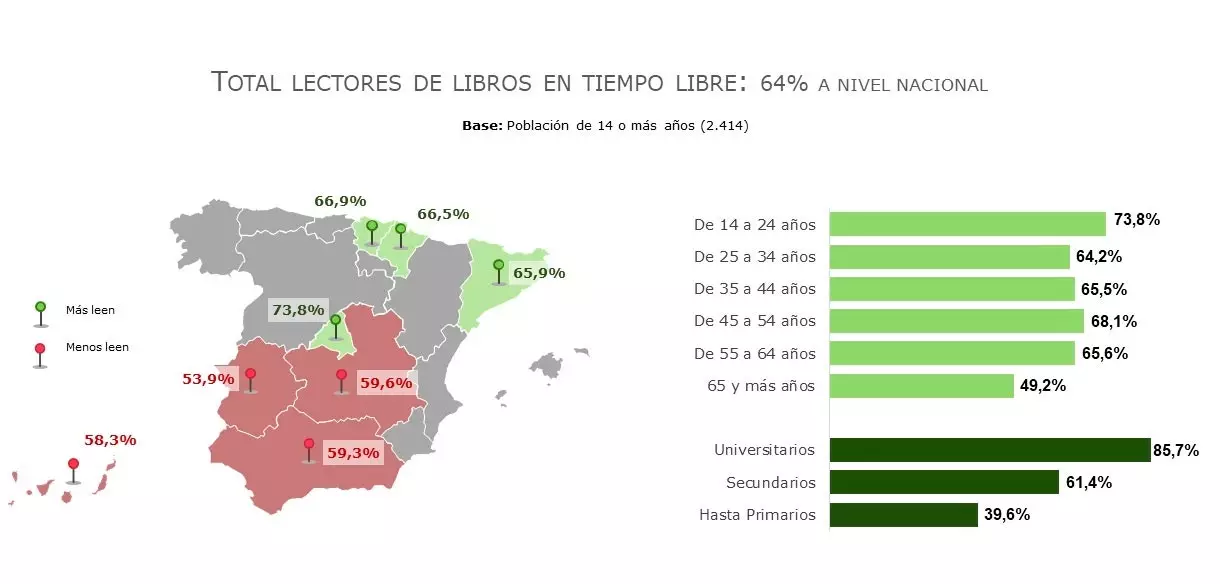
Total free time book readers
HOW MANY PEOPLE READ IN SPAIN?
68.8% of the Spanish population (aged 14 or over) read books, both on paper and digital). Of these, the majority, 64.0%, read books in their free time while 23.1% do so for work or study.
The reading of books for leisure has not stopped growing in the last ten years, accumulating an increase of 12.3%. Especially significant is the growth in this last year 2020 in which, on the contrary, the reading of books for work or studies decreased significantly (4.4%).
During 2020, the number of frequent readers especially grew (daily and weekly) of books in free time reaching. Currently, 52.7% of the Spanish population over 14 years of age read books weekly.
However, although with a downward trend, 36% of the population never or almost never read books.
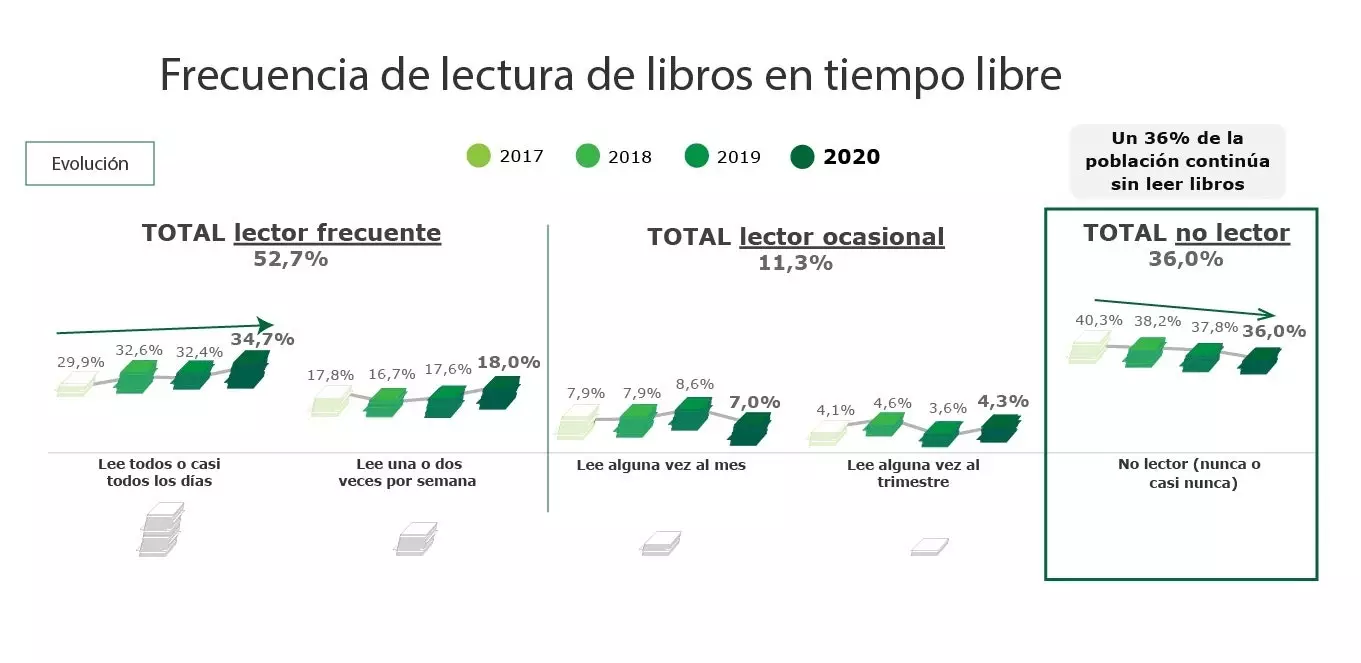
Frequency of reading books in free time
READING IN TIMES OF PANDEMIC
Book reading in Spain reached an all-time high during the months of confinement: 57% of frequent readers (weekly) and 8 hours and 25 minutes of reading per week.
A significant part of the increase in reading generated by the confinement has been maintained after the summer with 52.7% of weekly readers (almost 3% more than in 2019) and 7 hours and 25 minutes of weekly reading (30 minutes more than in 2019).
It is clear that the book has been an ally in 2020, helping to better cope with confinement, whose effect on reading occurred mainly among those under 35 years of age.
According to Barometer data, during confinement, reading played a positive role, contributing: entertainment (99% of readers), disconnection (97%), relaxation (93%), tranquility (90%), positive mood (83%), joy (77%), enthusiasm (66 %), enthusiasm and mental strength (at 63%) and security (at 48%).
“The book has played an important role in the lives of citizens. We all had to confine ourselves and our lives radically changed our consumption habits and many other things”, valued the president of the Federation of Publishers Guilds of Spain (FGEE), Patrici Tixis, together with the Minister of Culture and Sports, José Manuel Rodríguez Uribes.
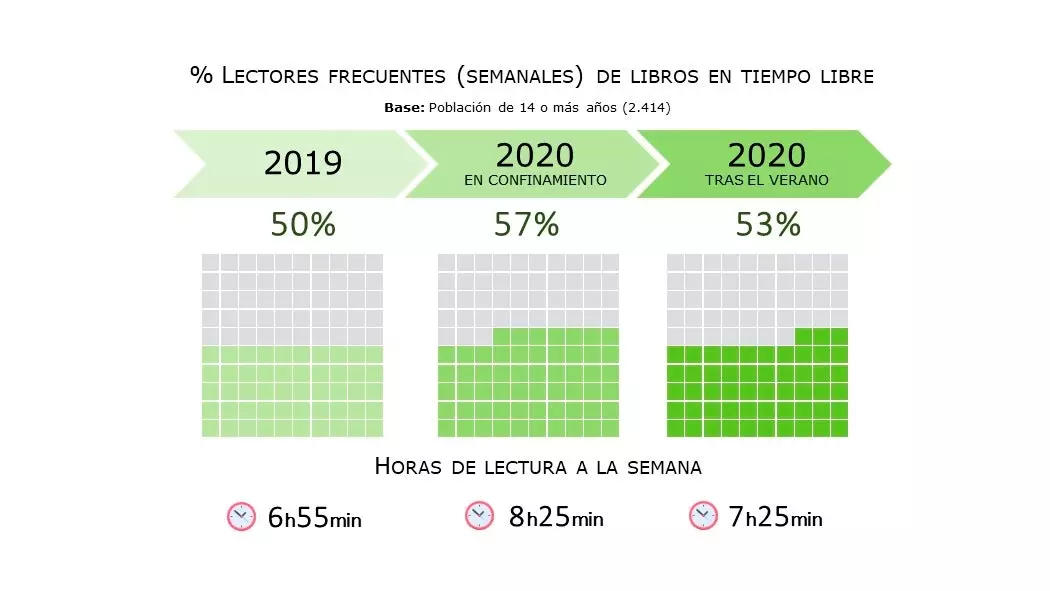
Weekly Frequent Readers
READING BY COMMUNITIES
The increase in the number of readers during 2020 has been generalized in all the Autonomous Communities, with a national average of 64% of leisure readers.
Growth was greater in Catalonia and Andalusia, where it rose 2.3 points compared to 2019. The Balearic Islands and Castilla y León have been the ones that have registered the least increase; 0.7 and 0.8, respectively.
The Community of Madrid leads the ranking, with 73.8% of readers in 2020, followed by the Basque Country (66.9%), Navarra (66.5%), Catalonia (65.9%), La Rioja (65.5%) and Aragón (65%).
The rest of the communities are below the average, being Castilla-La Mancha (59.6%), Andalucía (59.3%), Canarias (58.3%) and Extremadura (53.9%) read the least.
Thus, despite the improvement in book reading rates during 2020, Significant structural inequalities remain by region, age and educational level.
In terms of age, the section with the largest reading population is between 14 and 24 years old (73.8% of the population reading in free time). From the age of 25 there is a drop in reading rates (64.2%). It recovers around 35 years of age and falls again significantly among the population over 65 years of age (49.2% of the population)
Regarding the level of studies, 85.7% of the population with university studies read in their free time. The percentage drops to 61.4% among those with secondary education. 39.6% of the population that has only attended primary school is a free-time reader.
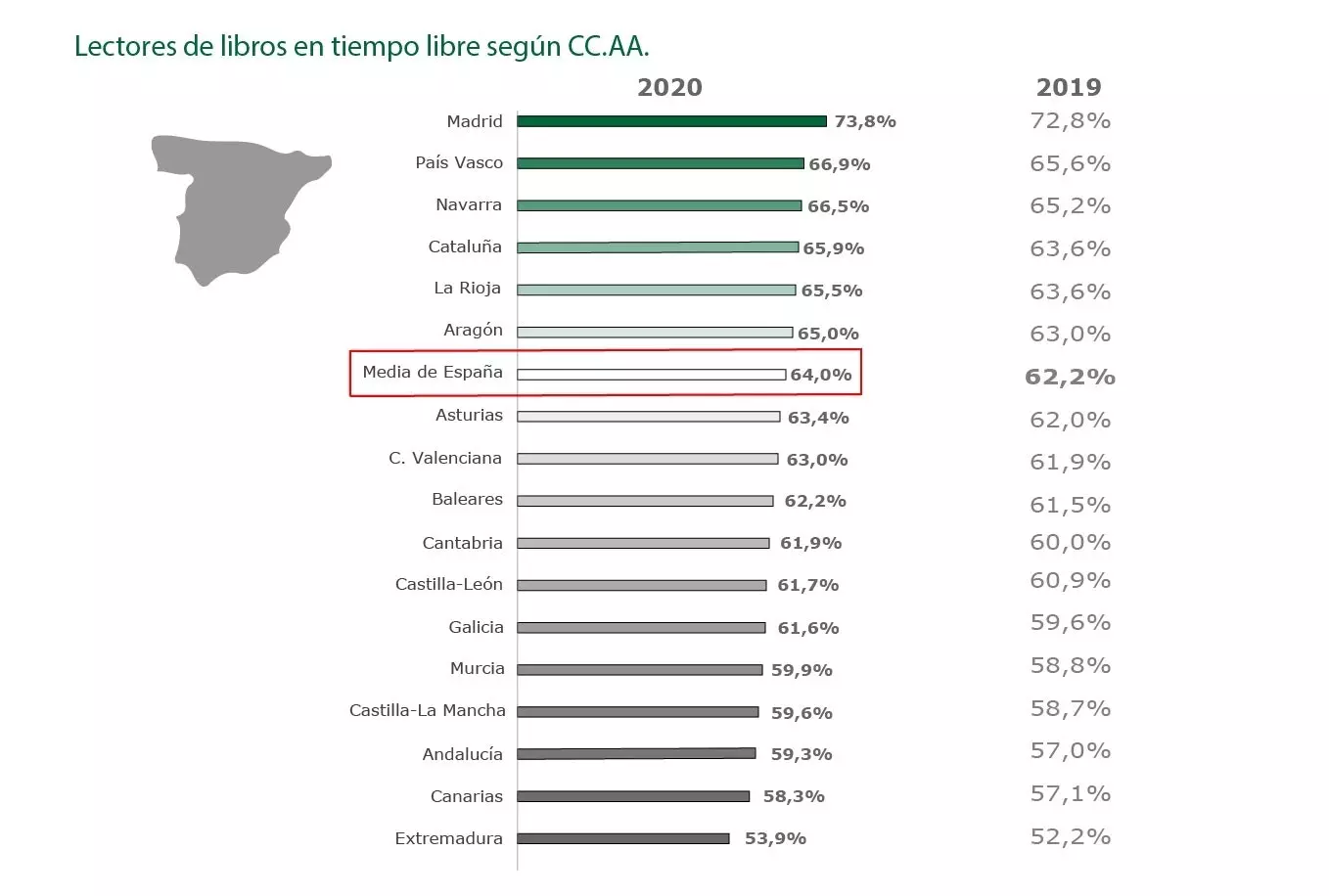
Readers by communities
MORE READERS
In all age groups, among women there is still a higher percentage of reading of books in leisure time than among men.
This difference is greater among the population between 45 and 64 years of age. (a total of 22 percentage points). The smallest distance is found in the age range of 35 to 44 years, with 69.5% of readers compared to 61.5% of readers (8 percentage points of difference).
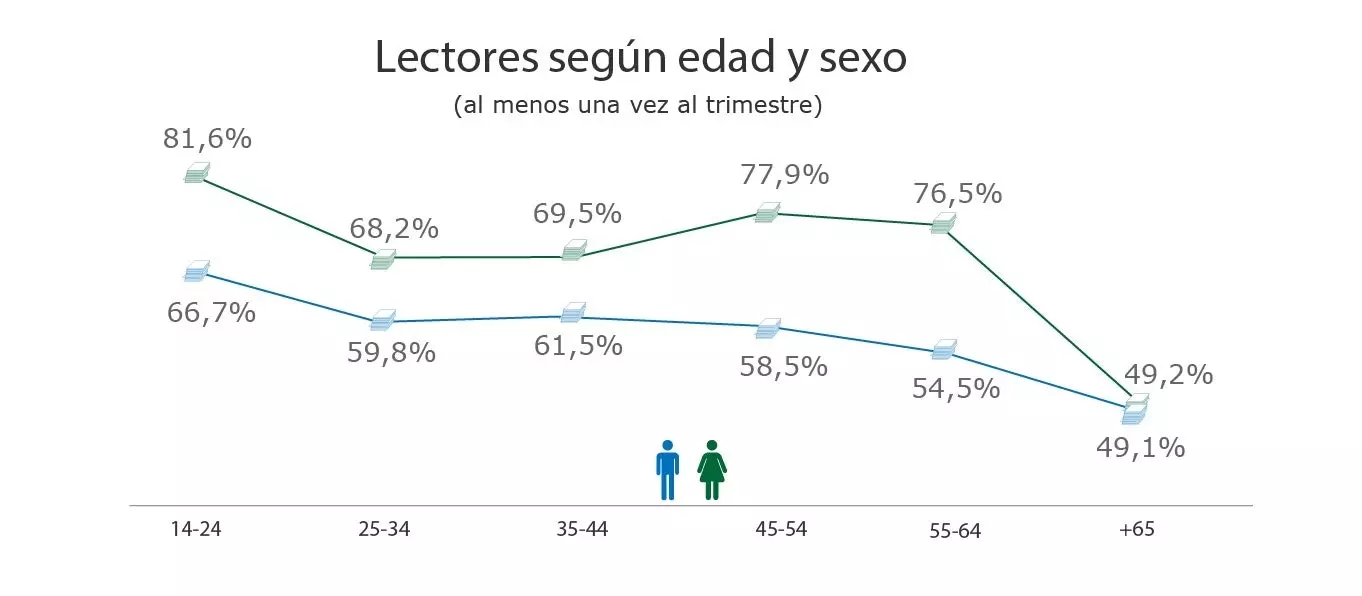
Readers by age and gender
THE RISE OF DIGITAL SUPPORT
30.3% of the population aged 14 or over already reads books in digital format at least once a quarter. E-Reader and computer the most used devices, with 12.6 and 12.5% of readers respectively. 10.1% read books on a tablet and 6.2% on a mobile.
WE BUY MORE
If the percentage of book readers has grown in 2020, so has the percentage of buyers. 51.7% of the population bought a book this year. This represents 1.3 points compared to 2019. If we analyze what has happened since 2010, the percentage of book buyers has increased by 11 percentage points.
One more year, the Barometer of Reading Habits and Buying Books shows that bookstores are the preferred places for readers to access books, which makes them establishments that must be preserved and helped, especially in situations such as those that are currently being experienced.
The traditional bookstore remains the main purchase channel of non-text books. 71.1% of buyers chose these establishments to purchase a copy.
Internet follows (including bookstore platforms), which was chosen by 38.4% of buyers in some of their purchases. Among the population between the ages of 25 and 44, this percentage rises to 49%.
After bookstores and the internet, the usual places of purchase are, from most to least relevant: chain of bookstores, department stores, hypermarkets, book fairs and markets, book club, kiosk, publishing house and study center.
Regarding the form of access to books in digital format, throughout 2020 the proportion of readers who paid for electronic books has increased notably (from 35% to 39.8%), although Those who obtain books without paying or download them for free from the internet continue to be the majority, 55%, a percentage that has grown slightly in 2020 (from 54.7% to 55%) after three years of decline (in 2017 the percentage was 64 %).
43.7% indicated that the way to access electronic books is through friends or family by USB, CD, e-mail, etc. This is a multiple choice, so some people buy some books, but others get them either for free or through friends.
“We must fight against piracy”, pointed out Óscar Chicharro, responsible for the study, which adds that "six out of ten of those interviewed who download electronic books for free know perfectly well when the download is not legal."
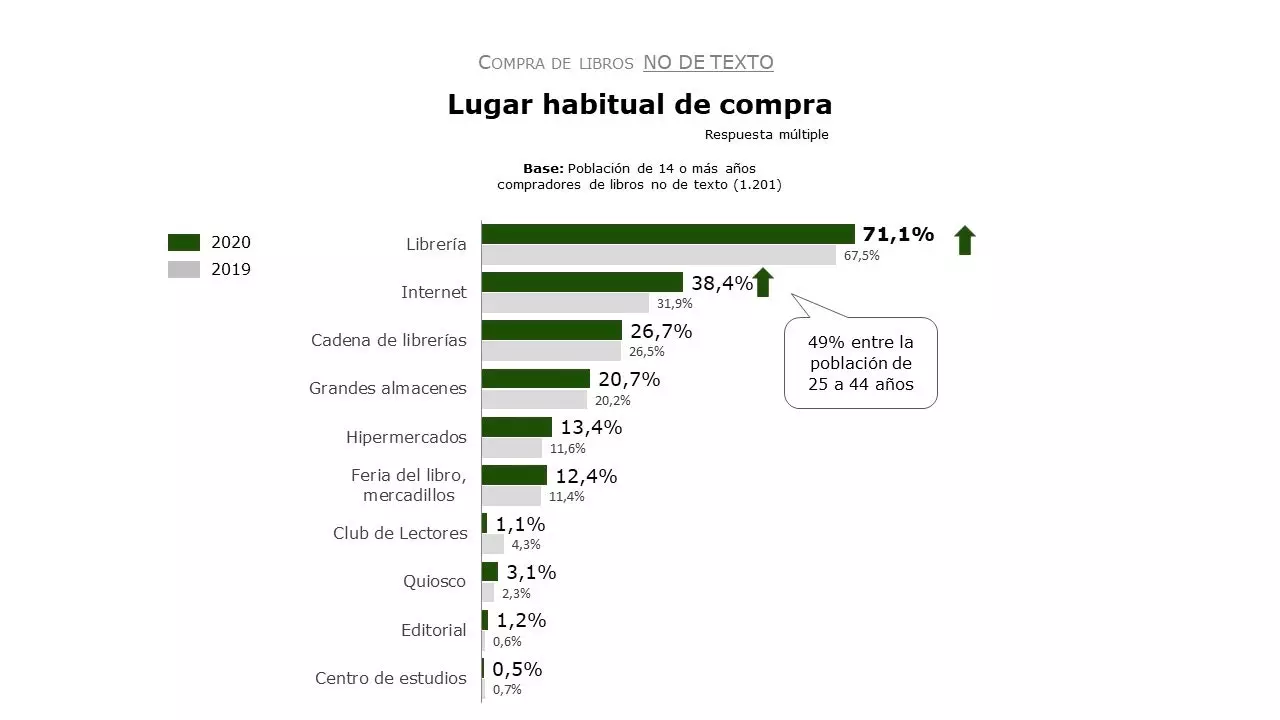
Usual place of purchase
THE LIBRARIES
The Reading Habits Barometer has analyzed the use of libraries for yet another year. As expected, In 2020, the number of visitors to libraries fell markedly due to restrictions to mobility and the suspension of the library service part of the year.
Last year, only 23.2% went to the library, compared to 32% in 2019. However, the excellent rating that citizens give their regular library remains: 8.3 out of 10.
The best valued libraries are those of Catalonia, with 8.8, followed by those of the Basque Country, Castilla y León and Cantabria. However, this year there has been a significant decrease in the use of these, from 32.0% in 2019 to 23.2% in 2020, as a result of mobility restrictions and the suspension of the library service for much of the year. year.
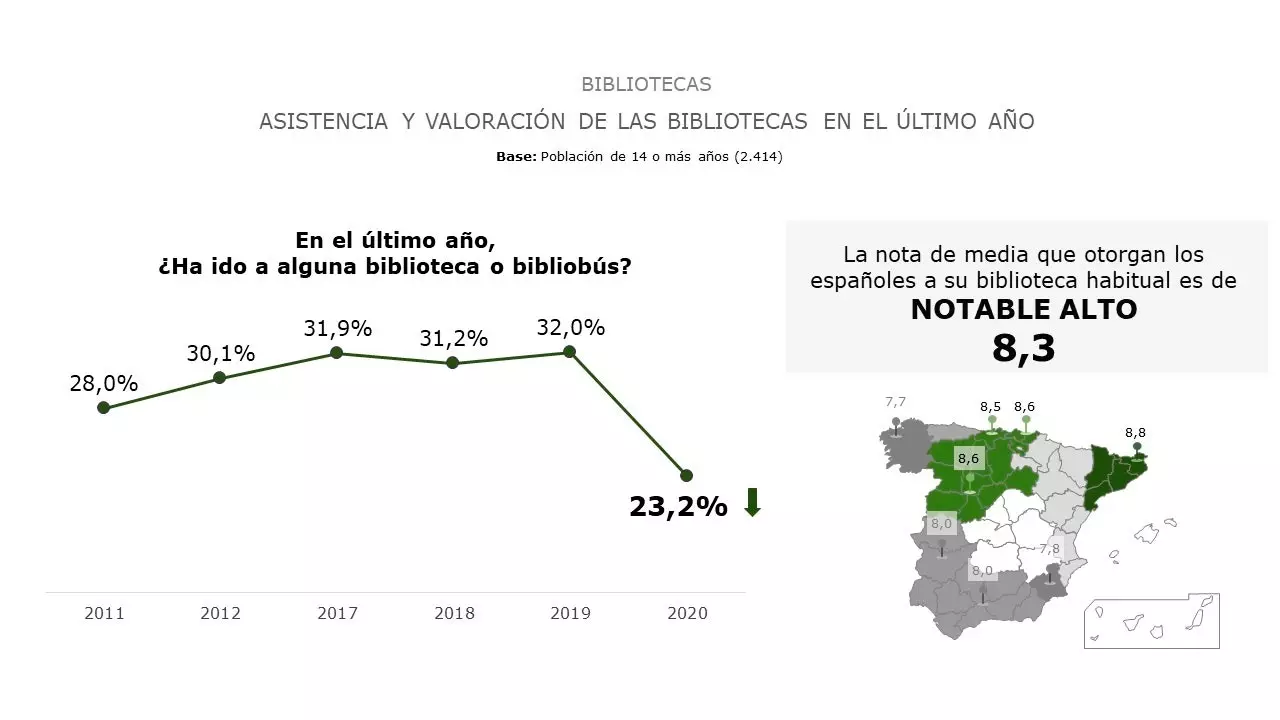
Assistance and assessment of libraries
AND WHAT ABOUT THE LITTLE ONES AND TEENAGERS?
Children's reading (children up to 9 years old) remains at very high values. In 74.4% of households with children under six years of age, the children are read. This figure represents a decrease compared to 2019, the year when a percentage of 83.6% was registered.
There is an increase among boys and girls from 6 to 9 years old who read non-text books, 2 percentage points more than in 2019 (86.8%). In both cases, the reading time per week is around three hours.
As was the case in previous editions of the Barometer, From the age of 15, the proportion of frequent free-time book readers is significantly reduced: If 79.8% of boys and girls between the ages of 10 and 14 are free-time readers (with an average of 10.6 books read in 2020), from the age of 15, this percentage drops to 50.3 %.
